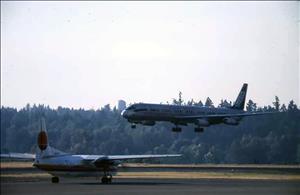On May 23, 1989, the Port of Seattle and Puget Sound Council of Governments (PSCOG), reorganized in 1991 as the Puget Sound Regional Council, sign an Interagency Agreement to launch the “Flight Plan” study of future air service capacity needs and solutions, including the possible expansion of the Seattle-Tacoma (Sea-Tac) International Airport. The effort is guided by a 39-member Puget Sound Air Transportation Committee and will lead to a controversial decision in 1992 to add a third “dependent” runway at Sea-Tac to maintain airport capacity during low visibility weather conditions.
The need for the “Flight Plan” effort was first identified in 1988 during preparation of the Port of Seattle’s “Comprehensive Planning Review and Airspace Update Study.” This analysis projected that the existing two runways at Sea-Tac International Airport could reach “maximum efficient capacity” by the year 2000. Planners and forecasters at the Puget Sound Council of Governments (PSCOG) and the Federal Aviation Administration (FAA) soon arrived at the same conclusion.
Seattle-Tacoma International Airport opened with one runway in 1944 and became fully operational in 1949. An additional runway was built 800 feet to the west in 1970 to accommodate increased air traffic and larger jetliners. This narrow separation prevented the use of both runways during fog and low clouds, or about 44 percent of the time, and capped the airport’s efficient capacity with minimum delays at about 380,000 operations (landings and takeoffs) per year.
Deregulation of U.S. airlines in 1978 stimulated competition within the airline industry and more than doubled the number of major carriers using Sea-Tac’s two runways. Airport operations grew by half again from 195,000 operations to 316,000 operations in 1988, while annual passenger counts nearly doubled from 8.4 million to 14.5 million during the same period. Port planners projected that Sea-Tac could reach 400,000 annual operations by 2000, resulting in significant flight delays during times of limited visibility. (Sea-Tac operations passed 385,000 in 1997 and peaked at nearly 446,000 in 2000 but then declined to 365,000 in 2002 due to slumps in the economy and in national air travel after the September 11, 2001, terrorist attacks.)
Port Aviation Division director Andrea Riniker (a former director of the Washington State Department of Ecology and later executive director of the Port of Tacoma) recognized that addressing air service capacity needs would require a credible and objective examination and, with luck, a regional consensus. The Port Commission and PSCOG began planning a joint study in July 1988. The final agreement was authorized by PSCOG Resolution 3042 and signed by director Curtis Smelser and his Port counterpart, Zeger J. J. van Asch van Wijck.
The Puget Sound Air Transportation Commission comprised 39 members representing the following groups and constituencies:
- six representatives of King County and its cities;
- two representatives of Pierce County;
- two representatives of Snohomish County;
- one representative of Kitsap County;
- four members of the Washington State Legislature;
- one representative of the Governor (then Booth Gardner);
- four representatives of the regional business community;
- three representatives of major airlines;
- one representative of the Washington Environmental Council;
- three representatives of the Port of Seattle;
- one representative of the Federal Aviation Administration;
- three unaffiliated citizens, one each from Kitsap, Pierce, and Snohomish counties;
- one citizen member of the Port of Seattle Noise Management Mediation Committee.
The Port and PSCOG agreed to split the Committee’s initial $683,000 budget down the middle. Work began almost immediately and continued over the next two-and-one-half years. The PSATC adopted its final report on June 17, 1992, which called for construction of a third dependent runway at Sea-Tac, addition of commercial airline service at Snohomish County's Paine Field, and development of a supplemental airport in Pierce or Thurston County. The Port and the Regional Council ultimately adopted its recommendations, but the third Sea-Tac runway was the only one to survive as a viable solution to the region’s projected air service capacity needs.

